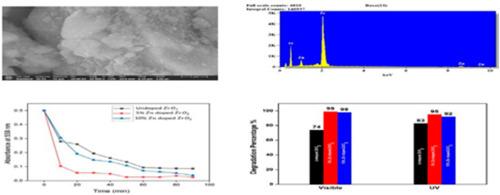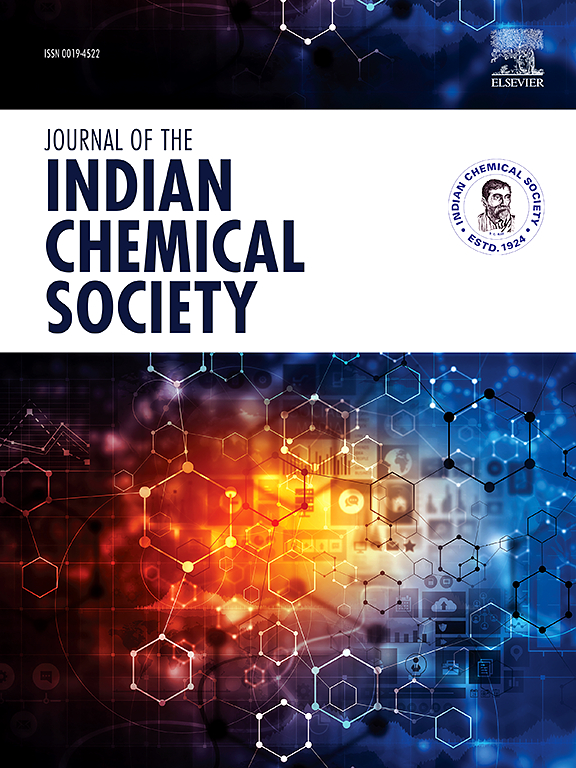Efficient photocatalytic degradation of Rhodamine B dye by undoped and zinc doped zirconium dioxide NPs
IF 3.2
4区 化学
Q2 CHEMISTRY, MULTIDISCIPLINARY
引用次数: 0
Abstract
Undoped and Zinc-doped Zirconium Dioxide (ZrO2) nanoparticles (NPs) were synthesized via the co-precipitation method, employing Zirconium (IV) Oxynitrate hydrate (ZrO2N2·xH2O), Zinc Sulfate (ZnSO4·7H2O), and ammonia solution as precursor materials at room temperature. A comprehensive characterization of the structural, morphological, optical, and catalytic properties of the prepared samples was conducted using various techniques. Powder X-ray diffraction (PXRD) analysis revealed that the synthesized NPs exhibited a tetragonal phase structure, with crystallite sizes decreasing as doping concentration increased. Scanning electron microscopy (SEM) images confirmed the spherical shape of the NPs. Energy-dispersive X-ray spectroscopy (EDX) verified the presence of Zr, O, and Zn elements with high purity. Raman spectroscopy corroborated the tetragonal structure of the synthesized ZrO2 NPs. Ultraviolet–visible (UV–Vis) spectroscopy studies determined the cutoff wavelengths, while Tauc plot enabled the calculation of band gap energies. Fourier transform infrared spectroscopy (FTIR) confirmed the functional groups present in the synthesized samples. Photoluminescence spectroscopy provided evidence of defects and charge carrier recombination processes. The catalytic efficacy of the synthesized ZrO2 NPs was demonstrated through the degradation of Rhodamine B dye under visible and UV light.

未掺杂和掺锌二氧化锆氮氧化物对罗丹明 B 染料的高效光催化降解
以水合硝酸氧化锆(ZrO2N2-xH2O)、硫酸锌(ZnSO4-7H2O)和氨溶液为前驱体材料,在室温下通过共沉淀法合成了未掺杂和掺锌的二氧化锆(ZrO2)纳米粒子(NPs)。利用各种技术对所制备样品的结构、形态、光学和催化特性进行了综合表征。粉末 X 射线衍射(PXRD)分析表明,合成的 NPs 呈四方相结构,晶体尺寸随着掺杂浓度的增加而减小。扫描电子显微镜(SEM)图像证实了 NPs 呈球形。能量色散 X 射线光谱(EDX)验证了高纯度 Zr、O 和 Zn 元素的存在。拉曼光谱证实了合成 ZrO2 NPs 的四方结构。紫外-可见(UV-Vis)光谱研究确定了截止波长,而陶氏硬度图则有助于计算带隙能。傅立叶变换红外光谱(FTIR)证实了合成样品中存在的官能团。光致发光光谱提供了缺陷和电荷载流子重组过程的证据。通过在可见光和紫外光下降解罗丹明 B 染料,证明了合成 ZrO2 NPs 的催化功效。
本文章由计算机程序翻译,如有差异,请以英文原文为准。
求助全文
约1分钟内获得全文
求助全文
来源期刊
CiteScore
3.50
自引率
7.70%
发文量
492
审稿时长
3-8 weeks
期刊介绍:
The Journal of the Indian Chemical Society publishes original, fundamental, theorical, experimental research work of highest quality in all areas of chemistry, biochemistry, medicinal chemistry, electrochemistry, agrochemistry, chemical engineering and technology, food chemistry, environmental chemistry, etc.

 求助内容:
求助内容: 应助结果提醒方式:
应助结果提醒方式:


